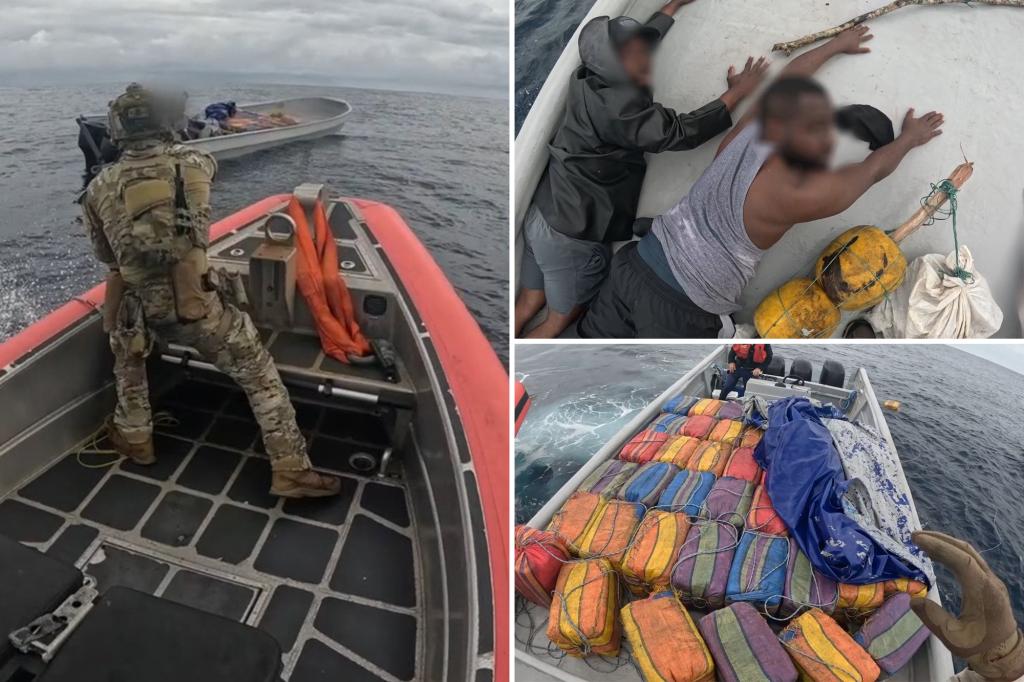High-Seas Drama: Coast Guard’s Stunning Capture of Drug Smugglers
In a daring pre-dawn operation, the U.S. Coast Guard intercepted a go-fast vessel smuggling over 2,500 pounds of cocaine worth $38 million in international waters 200 miles south of the Dominican Republic. The June 12, 2024, takedown—involving helicopter surveillance and tactical boarding teams—highlights escalating efforts to combat transnational drug cartels exploiting maritime routes. Authorities arrested six suspects in what officials call a “textbook example of interagency coordination.”
The High-Stakes Interception Unfolds
According to Coast Guard reports, the 45-foot vessel attempted evasive maneuvers when spotted by a Customs and Border Protection aircraft. The suspects jettisoned multiple bales of drugs before a Coast Guard MH-65 Dolphin helicopter deployed warning shots. A boarding team from cutter James later discovered:
- 122 individually wrapped cocaine bales hidden in compartments
- Two firearms and satellite communication devices
- Modified fuel tanks for extended range
“These traffickers invest millions in logistics, but so do we,” said Rear Admiral Jo-Ann Burdian, noting a 17% increase in Eastern Pacific seizures this year. The operation occurred in a known trafficking corridor where currents and sparse patrols facilitate smuggling.
Inside the Coast Guard’s Counter-Narcotics Strategy
With 85% of cocaine reaching the U.S. via maritime routes (UNODC 2023), the Coast Guard has deployed new tactics:
- Predictive analytics: AI models analyze historical data to pinpoint likely smuggling routes
- International task forces: 23 nations now share intelligence through Joint Interagency Task Force-South
- Enhanced technology: Unmanned drones provide 72-hour surveillance of suspect vessels
However, challenges persist. “For every vessel we stop, two may slip through,” admitted Lt. Commander Daniel Briggs, a 15-year interdiction veteran. “Cartels constantly adapt—using fishing fleets as cover or submersibles.”
The Human Cost of the Drug Trade
Behind the seized contraband lies a darker reality. The captured suspects—four Colombians and two Venezuelans—allegedly worked for the Sinaloa Cartel’s maritime division. “These aren’t kingpins; they’re desperate people earning $5,000 per run,” said Dr. Elena Marquez, a transnational crime researcher at Georgetown University.
Meanwhile, overdose deaths in the U.S. remain at record levels, with synthetic opioids now contaminating 60% of seized cocaine (CDC 2024). “Interdiction alone won’t solve this,” argued former DEA agent Mark Tolson. “We must reduce demand while pressuring source countries.”
Global Implications and Future Outlook
The seizure coincides with rising cocaine production in Colombia—a 24% surge to 1,400 metric tons in 2023 (White House report). European markets now rival U.S. demand, complicating enforcement. The Coast Guard plans to commission six new fast-response cutters by 2025, but funding debates continue in Congress.
As the captured vessel is towed to Florida for evidence processing, one question lingers: Will technology and teamwork outpace traffickers’ ingenuity? For now, this mission stands as both a victory and a reminder of the enduring battle at sea.
Call to Action: Stay informed about maritime security issues by subscribing to the Coast Guard Journal’s weekly briefing.
See more CNN Headline


